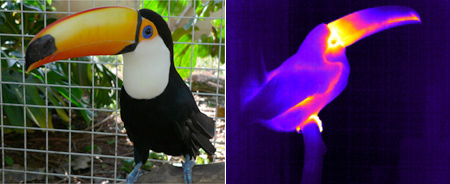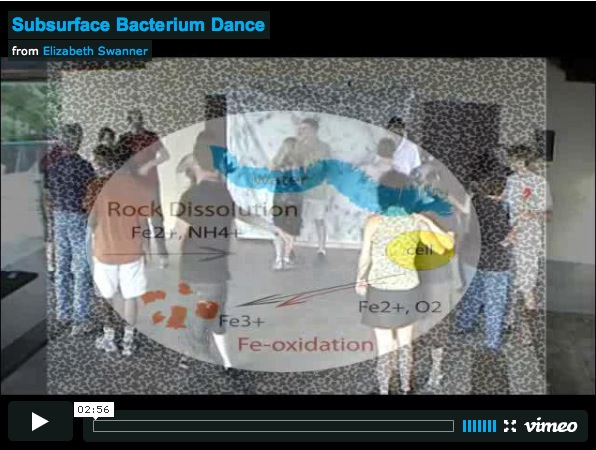) describes an experiment that provides evidence-based answers.  Tattersall, GJ et al. (2009) were able to measure how infrared temperature varied with the activity billed Toucan Ramphastos toco
Tattersall, GJ et al. (2009) were able to measure how infrared temperature varied with the activity billed Toucan Ramphastos toco
: They observed that the tip is heated (by places almost 40 ° C) just before the birds go to sleep, dissipating heat and explaining the drop in temperature of the animal in his sleep. (See Fig 1 and video here  Movie s1). They also measured a flying animal and observed the animal's temperature rise of 6 ° C: the need for cooling is important. Fig 1: The Toucan's bill effectively dissipates heat. The infrared image on the right shows hot spots in orange-white (about 40 ° C) where the toucan off heat. [Img
Movie s1). They also measured a flying animal and observed the animal's temperature rise of 6 ° C: the need for cooling is important. Fig 1: The Toucan's bill effectively dissipates heat. The infrared image on the right shows hot spots in orange-white (about 40 ° C) where the toucan off heat. [Img
] Source Glenn Tattersall.
-
Fig 2: The toucan's beak is richly vascularized, observe the ships that transparency makes it more visible. B: Sagittal: Bone is very light. C: The size of the beak grows faster than the rest of the body ("With positive allometry scales ). [Img
] Source: Glenn Tattersall. Figure
complete with legend
Birds do not sweat. Neither elephants elsewhere. Both live in hot climates and lose little heat in their bodies (for reasons very different pens or relative body surface cf.
Fig 3: is often explained by the elephant ears need to dissipate or conserve heat. African Elephant to G and India to Dr [ img] Source: Taronga.org
And in French?The beak is it not linked to diet? Some will like Gary Ritchison, ornithologist at Eastern Kentucky University in Richmond, this study shows that actually use their beaks toucans for thermoregulation, but this does not prove that this is the only factor that explains its astonishing size. There are so many other factors such as diet, defense etc.. Tattersall agrees but says that now it will also
consider thermoregulation to discuss the evolution of the beaks. This is one factor among others. How to view?
It may be noted that precisely this information to understand it is important to put it in perspective: Yes thermoregulation is an important factor in the shape of the tooth and as this information is new, it's normal that the authors bring to the fore, but this does not replace what has been said about the link between the shape of the spout and regime, this complete and nuance. Each teacher. Biology will do, but ... that will teach students to get back with this type of information disseminated in a free newspaper or on TV, and with a tone so much more catchy and beautiful images, ... How will the student he or she integrate new information with what he said at school? If it does not help to link what is said in biology class and the media, not likely he or she not remember what the sensationalist media communicate information rather than just dry some books? And ultimately to disqualify the school as a source of scientific information? Larger nozzles in warm climates?
More recently, a team led by Matt Symonds of the University of Melbourne in Australia, with the same Tattersall compared 214 species of birds from different parts of the world to see if the size of their beaks varied with the temperature regime their habitat.The authors started the previous results in thermal imaging showing that many birds dissipate heat through the spout (see Fig. 4).
- Figure 4: Infrared Images of various birds. We see how the beak often dissipates heat well [img ] Source: Symonds, Matthews, RE Tattersall, Glenn J. et al. (2010)
- They found among all groups except the finches ( Estrildidae ), a strong link between beak size and latitude, altitude or the minimum temperature ( see Fig 5). But no correlation with the length of the legs. This suggests to the authors that the beak is a more important source of heat dissipation the legs, and the need to regulate the temperature was an important factor in the evolution of jaws.
Fig 5: The log bill length correlates well with the latitude (A), Altitude (B), and the minimum temperature (C). [Img ] Source: Source: Symonds, Matthews, RE Tattersall, Glenn J. et al. (2010)-Excerpts
Intranet.pdfSymonds et al. therefore provide strong evidence that birds cold areas (in latitude or altitude) generally have smaller beaks relative to their body. Such as penguins (see Figure 6).
Fig 6: The beak of the penguin is relatively small: Aptenodytes forsteri [
img] Source: Naked Scientist 27th May 2010© Dbush @ Wikipedia
The authors believe that heat favors larger nozzles for heat dissipation, but it is more likely that the cold limits the size of the beaks. Indeed, a large nose that dissipates the heat would be too big a problem in the cold whatever may be the benefits such as communication or attraction to partners, but the heat allows many other parameters appear.
The law of Allen resurrected?
- Rule Allen (
- wikipedia) which dated from 1877 predicted that homeothermic cold areas of the globe are moving towards smaller extremities (ears, paws, tails) than in warm climates. So that we find the trace-often without explicit mention of Allen - in many excellent textbooks that law was considered by most researchers as obsolete ((Scholander 1956) Described The Rule has HAVING been "Demolished") , but the authors are happy to put it back in the spotlight: the first well-documented study that supports it.
Those who want a simple certainties of science learning will be disrupted. But not much, because the textbooks had not really abandoned Allen ... Those who appreciate that science calls into question his theories when new data appears and see science as an ongoing debate will be happy to see it live.
" The topics taught are no longer producing knowledge alive in the public schools invited to revere the works - mathematical or otherwise - that teaching requires them to" know. "Thus, for example, will not know how to draw a figure "three times smaller" than a given figure [...]. But it will be assumed to know in detail the properties of the dilation! Knowledge monumental insistent, actual knowledge evanescent ... Chevallard, Y. (2004)
 A monument of education?
A monument of education? Only time will tell if the law of Allen reborn or will one of these school knowledge have lost contact with the research (the "degeneration monumentalist" Chevallard) that exist in the world of school, or only as a sign of recognition of "educated". He cites the Pythagorean triangle, I would add also the "universal donor" in the blood groups: very popular in conversations, but that does not correspond to the practice of transfusion in normal times. (I look forward to your reactions ...)
I do not implying that we should stop teaching these examples, but recent data suggests that Symonds, et al. allow students-actively guided by their teachers are - to build a scientific knowledge based on experimental data to develop a documented justification: knowing what we decide scientifically accepted as true. This is a new possibility given to us to let them practice science. Each according to his methods and his public. For example, to compare these results with students in recent books and academic materials, as did a teacher who discovered that the experience of "4 taste on the tongue" no longer corresponds to what we know (" Put the students in the role of the expert critical to teach them to sort? "Bio- Springboard
 January 6, 2009). She said they loved being in the role of experts, and were able to develop a spirit of constructive criticism. The authority to discipline the teacher of biology and have not been compromised, but enhanced. Sources
January 6, 2009). She said they loved being in the role of experts, and were able to develop a spirit of constructive criticism. The authority to discipline the teacher of biology and have not been compromised, but enhanced. Sources Chevallard Y. (2004). Instead of living in mathematics education secondary mathematics education and implementing new educational epistemology Paper Presented at the 3rd Summer School Animath 22-27 August 2004 Saint-Flour (Cantal). Darwin, C. (1871). The Descent of Man: And Selection in relation to Sex, John Murray, London, 1871, Volume II, 1st edition, 1871, p. 227. (Accessed via: The Complete Work of Charles Darwin Online , \u0026lt;darwin-online.org.uk>). Etienne, V. (2009).
. Science et Vie Septembre 2009 p. 18 extraits intranet.pdf Fischesser, B., Dupuis-Tate, M. F., Moyne, M. L., & Sardat, N. (1996). Le guide illustré de l'écologie: Ed. de la Martinière: Cemagref Ed.
Price, Michael (2009) A Bird With a Big Air-Conditioning Bill Science NOW Daily News 23 July 2009  Pontzen, Andrew, Scales, Helen, SmithChris. (2010). Smaller beaks for colder climates . Naked scientist 27th Jun 2010 Scholander, P. F. 1955. Evolution of climatic adaptation in homeo- therms. Evolution 9:15–26. Symonds, Matthews, R. E. Tattersall, Glenn J. et al. (2010).
Pontzen, Andrew, Scales, Helen, SmithChris. (2010). Smaller beaks for colder climates . Naked scientist 27th Jun 2010 Scholander, P. F. 1955. Evolution of climatic adaptation in homeo- therms. Evolution 9:15–26. Symonds, Matthews, R. E. Tattersall, Glenn J. et al. (2010).
Geographical Variation in Bird Species Bill Size across Provides Evidence for Allen's Rule. American Naturalist. Flight 176 ( PDF)

0 comments:
Post a Comment